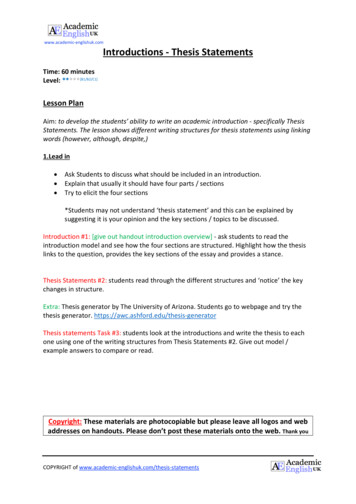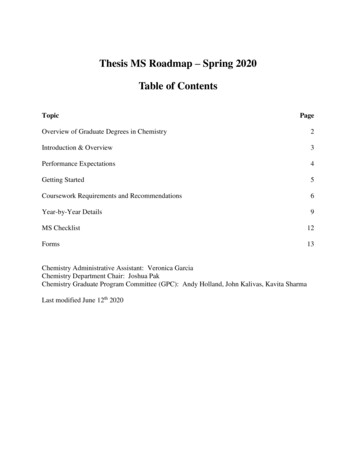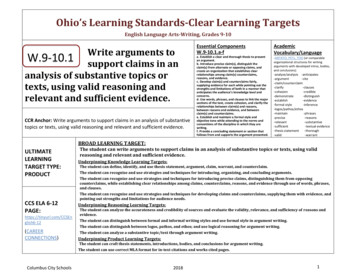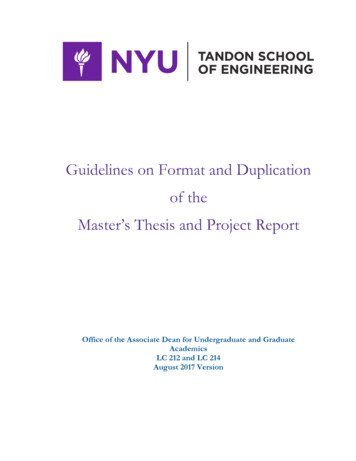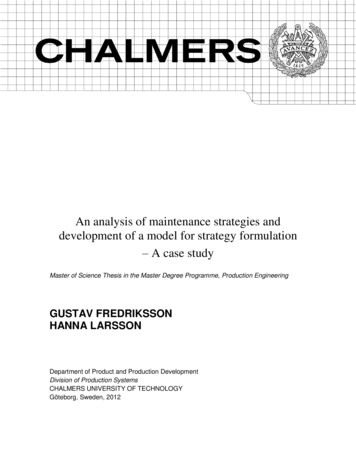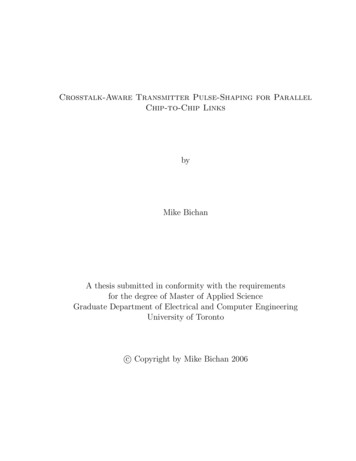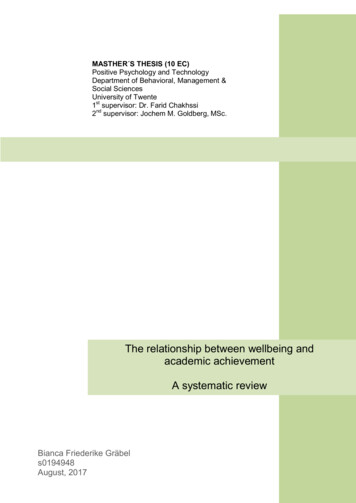
Transcription
MASTHER S THESIS (10 EC)Positive Psychology and TechnologyDepartment of Behavioral, Management &Social SciencesUniversity of Twente1st supervisor: Dr. Farid Chakhssi2nd supervisor: Jochem M. Goldberg, MSc.The relationship between wellbeing andacademic achievementA systematic reviewBianca Friederike Gräbels0194948August, 2017
Table of contentsPage1.Introduction41.1Positive Psychology41.1.151.3Wellbeing as a multidimensional conceptPositive psychology at school61.3.16The importance of positive emotions at school1.4Objective of the present study81.5Research questions82.Method92.1Search strategy and search terms92.2Selection of studies102.2.110Inclusion and exclusion2.3Data extraction133.Results133.1Characteristics of the selected studies133.2The relationship between the three dimensions of wellbeing and academic20achievi achievement3.33.2.1The relationship between emotional wellbeing and academic achievement203.2.2The relationship between psychological wellbeing and academic achievement21Possible moderators and mediators of the relationship between academic22iiiiiiiiiii achievement and nterpersonal relationship with teachers223.3.4Organizational justice at school223.3.5Student s perceptions of school and motives for attending school234.Discussion234.1Findings234.2Strengths, limitations and implications for further research264.3Conclusion27References281
AbstractBackground: Various studies have underlined the beneficial effect of wellbeing on mentalhealth as well as on resilience against stress and psychopathology. Also in the educationalsector several studies have indicated that interventions, based on the principles of positivepsychology, enhance wellbeing and resilience of students. Less is known about therelationship between wellbeing and academic achievement. To make positive interventions atschool more effective and purposive, advanced knowledge of the relationship betweenwellbeing and academic achievement and their influencing factors is needed.Method: The systematic literature review was conducted in December, 2016. The databasesScopus and Web of Science were searched for relevant literature by combining the searchterms wellbeing, school and academic achievement and several synonyms of these terms. Thisresulted in a pool of 300 studies. The application of several criteria of exclusion resulted in afinal selection of 5 studies.Results: The selected studies suggest that there is a positive relationship between emotionaland psychological wellbeing and academic achievement. The relationship of social wellbeingand academic achievement has not been examined in the included studies. In general studentswith higher levels of psychological and emotional wellbeing also show higher levels ofacademic achievement. Engagement, self-esteem, organizational justice, interpersonalrelationship with teachers, student s perception of school and motives for attending schoolmay moderate or mediate the relationship between wellbeing and academic achievement.Discussion/Conclusion: This systematic review is a first attempt to get an overview ofexisting studies regarding the relationship between academic achievement and wellbeing andprovides useful information that can serve as a starting point for further, more specificresearch in this area. Positive emotions, the fulfillment of basic needs, intrinsic motivation,personal strengths and engagement are supposed to influence in the relationship of wellbeingand academic achievement.2
SamenvattingAchtergrond: Verschillende studies hebben aangetoont dat welbevinden een gunstige effect heeft opde geestelijke gezondheid evenals op weerbaarheid tegen stress en psychopathologie. Ook laten eenaantal studies zien dat interventies, gebaseerd op de principes uit de positieve psychologie, welzijn enveerkracht van studenten verbeteren. Uit wetenschappelijke literatuur blijkt dat minder bekend is overde relatie tussen welzijn en academische prestaties. Om positieve interventies op school efficiënter endoelgerichter te maken, is meer kennis nodig over de relatie tussen welzijn en academische prestatiesen de beïnvloedende factoren.Methode: Een systematische literatuurstudie werd uitgevoerd in december 2016. In de databasesScopus en Web of Science werd gezocht naar relevante literatuur. Hiervoor worden de zoektermenwelzijn, school en academische prestaties en een aantal synoniemen van deze begrippen met elkaargecombineerd. Dit resulteerde in een pool van 300 studies. De toepassing van verschillendeexclusiecriteria resulteerde in een uiteindelijke selectie van 5 studies.Resultaten: Er bestaat een positieve relatie tussen emotioneel en psychisch welbevinden enacademische prestaties. De relatie tussen sociaal welbevinden en academische prestaties was nietonderzocht in de geselecteerde studies. Leerlingen met een hoger niveau van psychisch en emotioneelwelbevinden laten ook een hogere academische prestatie zien. Verder zijn betrokkenheid,eigenwaarde, interpersoonijke relatie met leeraren, gerechtigheid in organisaties, percepties van schoolen motieven voor aanwezigheid op school als factoren, die de relatie tussen welbevinden enacademische prestaties modereren of medieren, geïdentificeerd.Discussie / Conclusie: Deze systematische review is een eerste poging om een overzicht te geven vanbestaande studies, over de relatie tussen academische prestaties en welbevinden. De resultaten vormeneen uitgangspunt voor verder, meer specifiek onderzoek op dit gebied. Er zijn aanwijzingen datpositieve emoties, bevrediging van basisbehoeften, intrinsieke motivatie, individuele sterke kanten enbetrokkenheid de relatie van welbevinden en academische prestaties mogelijk beïnvloeden3
1.IntroductionThis introduction first illustrates the rise of positive psychology as a new field of psychologyand presents the concept of wellbeing as a core element of this movement. In the followingsection the role of wellbeing and positive emotions in the educational system is outlined and ashort overview of positive psychology interventions at school is given. The section ends upwith an outline of the practical relevance of the study at hand that underlines the necessity toget a deeper insight in the relationship between wellbeing and academic achievement toimprove positive school interventions in the future. Based on this intention three researchquestions are formulated.1.1Positive PsychologyUntil the millennium shift 16 year ago, the mental health sector was mainly dominated by theso called medical model. According to this model, (mental) health is defined by the absenceof dysfunctions and symptoms of illness. The health care system was focused on treatingillness by reducing its symptoms and negative effects (Seligmann & Csikszentmihaly, 2000).In this context Maddux (2002) introduces the term “Disease ideology” that underlines thegreat importance that was accredited to abnormal and deviating elements of diseases. Themental health sector was so strongly dominated by negative aspects of diseases that thepromotion of positive aspects of functioning was nearly neglected in the process of treatment(Maddux, 2002). Already in the year 2000 Seligman & Csikszentmihaly adviced against therisk of reducing people to their problems and disabilities as a consequence of the illnessfocused approach. In this regard they underline the basic necessity for a radical shift in thefield of psychology. This shift resulted in a more holistic framework of mental health,wherein the promotion of mental health and positive functioning is an important aspect. Inthis connection it becomes obvious that the definition of mental health as the absence ofillness is too limited and needs to be broadened (Seligmann & Csikszentmihaly, 2000). Inaddition, the World Health Organization renews its definition of mental health in 2005:Mental health is “A state of wellbeing in which the individual realizes his or her own abilities,can cope with the normal stresses of life, can work productively and fruitfully and is able tomake a contribution to his or her community.”(WHO, 2005, p. 5). Mental Health is not justthe absence of mental illness but is also expressed by wellbeing and positive functioning.As a reaction on the above mentioned paradigm shift, away from exclusively focusing onnegative aspects of human functioning, to a more holistic framework that emphasizes the roleof strengths and positive functioning, the field of positive psychology, as a science of4
wellbeing and positive emotions has emerged (Seligman and Csikszentmihaly, 2000).The concept of wellbeing is a core element of positive psychology. This makes it important toinvestigate the role of wellbeing in mental health promotion.Various studies have examined the impact of wellbeing on mental health andpsychopathology. According to Diener & Chan (2011) wellbeing is associated with a longerand healthier life. Furthermore, a study of Lamers (2012) shows that wellbeing serves aprotective factor against psychopathology. An example is its protective function against burnout (Bakker, Demerouti & Euwema, 2005). According to Cohn, Fredrickson, Brown, Mikels& Conway (2009) people who experience more wellbeing are better able to deal with dailystruggles and stressful life events.These findings indicate that wellbeing plays a crucial role in the process of achievingand maintaining mental health. Therefore, it is necessary to take a closer look at theconception of wellbeing.1.1.1 Wellbeing as a multidimensional conceptAs the above mentioned definition of mental health of the WHO (2005) has already indicated,wellbeing is a multidimensional construct consisting of psychological, emotional and socialaspects of functioning. In the following the three dimensions of wellbeing are outlined indetail.Psychological wellbeingPsychological wellbeing is made up of several components at 6 dimensions: A person with ahigh level of psychological wellbeing strives for an aim in life (purpose in life), experiencescontinuously personal development (personal growth) and got the impression to be able toinfluence his environment (environmental mastery) (Ryff & Singer, 2006). Furthermore,people, scoring high on psychological wellbeing, have a positive view against oneself (selfacceptance), experience independency and self-determination regarding their thoughts andactions (autonomy) and have close relationships with others, based on mutual trust (positiveinterpersonal relationships). Ryff & Singer (2008) revealed that psychological wellbeing issystematically related to a higher social economic status (SES) in terms of educationalattainment.Social wellbeingThis component of wellbeing refers to optimal functioning in society. According to Keyes5
(1998) social wellbeing consists of 5 dimensions. Social wellbeing is characterized by apositive attitude towards other people, the belief in growth of society, understanding ofsociety, participation in society and identification with society. Findings of Keyes (1998) andKeyes & Shapiro (2004) illustrate that social wellbeing is related to social economic status(SES) and higher education.Emotional wellbeingEmotional wellbeing refers to the individual experience of wellbeing. The combination ofpositive and negative emotions as well as satisfaction with the own life together determine theunique degree of emotional wellbeing (Diener, 1984). Research has indicated that emotionalwellbeing is related to better health and longer life (Diener & Chan, 2011).The above outlined focus on the promotion of wellbeing has been applied in severalinterventions at different dimensions of society. In this study it is focused on positivepsychology interventions in the educational system. The following paragraph gives a shortoverview of already implemented positive interventions at school and underlines theimportant role of positive emotions in the context of learning.1.3Positive Psychology at schoolPels (2011) defines the individual personal development as an important function of school.Students at school should develop abilities and competences in terms of academicachievement, but on the other hand the development of strengths and the development ofabilities regarding the determination of the own life, the construction of positive relationshipswith others and regarding coping with misfortune, are just as important.The focus on wellbeing and personal strengths in positive psychology is in line withthe aims of education formulated by Delors (1996): Learning to know, learning to do, learningto be and learning to live together. Research has already indicated that the promotion ofwellbeing and resilience can heighten satisfaction with life and can support creative thinkingas well as better learning (Seligman, Gillham, Reivich & Linkins, 2009).1.3.1 The importance of positive emotions at schoolThe experience of positive emotions is related to more creative thinking (Fredrickson, 1998,2004). This is what makes them important in the context of education. Here positive emotionscan promote the process of inventive and empathetic thinking (Seligman et al., 2009).6
Also in terms of motivation positive emotions play an important role in education. Froiland,Oros, Smith & Hirchert (2012) claim that intrinsic motivation is determined by positiveemotions. A higher level of intrinsic motivation is in turn related to greater involvement atschool, what is identified as a crucial determinant of academic achievement (Archambault,Janosz, Fallu & Pagiani, 2009).The crucial function of positive emotion in the context of learning can be bestunderstood in terms of the “Broaden-And-Built-Theory” of Barbara Fredrickson (1998,2004). According to Frederickson (1998, 2004) does the experience of negative emotions leadto a reduction in attention. This limitation in attention resulted in turn in a linkage betweencertain negative emotions and specific patterns of behavior. In contrast positive emotions leadto a spread of attention, cognitions and behaviors. Positive emotions are not directly linked tocertain behaviors but rather stimulate diverse behavioral reactions. This is what Fredrickson(1998, 2004) names the “broaden-effect” of positive emotions. The build-effect inFredrickson s theory refers to the longtime effects of positive emotions. These kinds ofemotions stimulate the development of effective and long-lasting resources in terms ofproblem solving. These resources are more constant than the positive emotion self and can beeffective in the process of problem solving in the future, too. Together the broaden- and thebuild-effect of positive emotions lead to increased wellbeing (Fredrickson, 1998, 2004).The promotion of positive emotions is one central element of the positive schoolintervention “Lectures of happiness”. Besides it is also focused on personal strengths andpositive relationships towards each other. The program is aimed at creating a new climate atschool that is characterized by empathetic relationships towards each other and the awarenessthat happiness is achievable (Stichting Lessen In Geluk, 2016). Research has indicated thatthe intervention has a positive effect on academic achievement in terms of grades. It ispossible that the lectures of happiness have lead to more wellbeing and more socialinteractions what in turn has a positive influence on school performance (Boerfijn &Bergsma, 2011). At the Geelong Grammar School the principles of positive psychology areapplied in a so called “Whole school approach”, wherein students and teachers are involved tocreate a positive school climate. In trainings students and teachers are amongst othersstimulated to get a deeper insight in their own positive emotions, to be able to recover and tokeep them. Moreover a strengths approach wherein individual character strengths areidentified and effectively used is applied. Students are motivated to use own strengths toachieve positive outcomes for themselves and for others (Geelong Grammar School, 2016).7
1.4Objective of the present studySeligman, Gillham, Reivich & Linkins (2009), claim that wellbeing as an important conceptin positive psychology, also needs to be seen as a core element of education. Several studieshave illustrated that positive interventions at school are effective at different dimensions.Findings of Durlak, Weissberg, Dymnicki, Taylor & Schellinger (2011) indicate that thesekinds of interventions have positive effects on social behavior and academic achievement.Furthermore a meta-analysis of 23 positive interventions, implemented at school, shows thatpositive interventions promote wellbeing and resilience of students. Students in theintervention group show more effective coping- and problem solving strategies compared tothe control group (Van der Linden, 2012). The registered effects of these interventions aremostly small or middle (Van der Linden, 2012; Brunwasser, Gillham, & Kim, 2009). Thefindings indicate that positive psychology at school is a promising field of research andunderline the necessity to implement positive psychology interventions at school as well as tomake those interventions more effective. But what is already known about the effects ofpromoting wellbeing on academic achievement?Examining scientific literature in this context let see that the field of wellbeing ofchildren at school and its relationship with academic achievement lacks a scientific base. Asabove outlined, several studies indicate that positive psychological interventions at schoolhave a positive effect on several student variables such as wellbeing and academicachievement (Durlak, Weissberg, Dymnicki, Taylor & Schellinger, 2011, Van der Linden,2012). However less is known about the direct relationship between wellbeing and academicachievement in this context. This branch of positive psychology at school is just at itsbeginning and the effects of promoting wellbeing on academic achievement need to beresearched further (Bohlmeijer, Bolier, Westerhof & Walburg 2015). Consolidated knowledgein this research area is needed to make positive school interventions more effective andpurposive.In addition, the objective of the current study is to give an overview of existingscientific literature that examines the relationship between wellbeing and academicachievement. This objective results in three research questions introduced in the followingparagraph.8
1.5Research question and sub-questions1.What is known about the relationship between wellbeing and academic achievement inscientific literature today?To answer this question the following sub-questions are taken into account:2.Which concepts of wellbeing are related to academic achievement in these studies?3.Which factors might moderate or mediate the relationship between wellbeing andacademic achievement?2.MethodIn this section the procedure of the systematic literature review is described. The useddatabases, the developed search strategy and the process of study selection are outlined andillustrated.In December 2016 a systematic literature review has been conducted to answer theabove mentioned research questions. The scientific databases Scopus and Web of Science areused to search systematically for relevant literature.2.1Search strategy and search termsIn the databases it is systematically searched for studies that examine the relationship betweenwellbeing and academic achievement. Several search items, related to these two mainconcepts (synonyms), have been used. These terms have also been entered in the databases. Itis made use of the function “AND”/ “OR” to find combinations of the search items in the title,in the abstract or in the keywords (Scopus) or in reference to the articles topic (Web ofscience). This strategy should heighten the chance to find topic relevant articles. The searchitems that have been used are illustrated in table 1 and table 2.9
Table 1 Used search itemsMain search itemRelated search itemsSynonymsacademic achievement(OR)school performance,gradeswellbeing (OR)social wellbeing,psychological wellbeing, emotionalwellbeingschool (OR)primary school, secondary schoolChosen synonyms for the main search term “academic achievement” are “schoolperformance” and “grades”. Next to the global term wellbeing, also its three components,social, psychological and emotional wellbeing are integrated into the search string. This ismainly important in reference to the second research question. Other related terms as lifesatisfaction or happiness are not taken into account, because the study at hand is exclusivelyfocused on the relationship between the concepts of wellbeing and academic achievement. Tospecify the context of the studies of interest, the item “school” has been added to the searchstring. The terms primary and secondary school are chosen to concretize this item. The majortarget group of this study is namely represented by students of primary or secondary schools.In table 2 the basic search string is split of by synonyms of the search term “academicachievement” to illustrate the different underlying search actions.10
Table 2 Used commands and combinations of search itemsUsed commandsCombination of search itemsAND, ORacademic achievement AND wellbeing OR psychological wellbeing OR socialwellbeing OR emotional wellbeing AND school OR primary school ORsecondary schoolschool performance AND psychological wellbeing OR social wellbeing ORemotional wellbeing AND school OR primary school OR secondary schoolgrades AND wellbeing psychological wellbeing OR socialwellbeing OR emotional wellbeing AND school OR primary school ORsecondary school2.2Selection of studiesThe criteria to determine which studies have been included for further analysis aresummarized in the following section. The process of selection is also pictured in a flowchart.2.2.1 Inclusion and exclusionStudies that are included for the further selection process need to be published in English,Dutch or German in the period between the year 2000 and 2016. Selected studies need to becategorized in one of the following research areas Psychology, Social Sciences, Art as well asHumanities and Health Professions (Scopus) and Psychology multidisciplinary, Educationand educational research, Psychology Developmental, Social Science Interdisciplinary,Psychology Social, Psychology Educational and Psychology Applied (Web of science),because this thesis is focused on psychological and social aspects of the relationship betweenwellbeing and academic achievement.The first search resulted in a pool of 300 studies. Studies not written in English, Dutchor German have been excluded. Only studies, meeting the above mentioned criteria ofinclusion have been selected. This leads to a collection of 152 studies. The title and theabstract of these studies have been scanned to check whether the main concepts of the thesisat hand (wellbeing and academic achievement of primary or secondary students and/ormoderators) are topic of interest. To be included the key terms academic achievement and/ orwellbeing (as well as their synonyms) need to be included in the title of the paper.Furthermore it is outlined in the abstract of the included paper that it is intended to examinethe relationship between wellbeing and academic achievement (research question 1, 2) or toexamine next to the relationship between wellbeing and/or academic achievement, also their11
relationship with other concepts in the context of school (research question 3) in a quantitativeway. 11 papers have been excluded because there was no free full text available. 3 duplicates,2 reviews and 1 conference paper have been removed. Besides 130 studies do not meet thecriteria referring to title and/or abstract. This results in a total collection of 5 studies that arechosen for further, detailed analysis of content.The whole selection process is illustrated in the following flowchart.Figure 1: Flowchart selection of studiesN 148 papers have beenexcluded because:Not published between 2000 and2016,Data collectionLanguage English, German orDutchNumber of papers found through search indatabasesScopus:N 134Web of Science:N 166Total:N 300ScreeningNumber of papers meeting the inclusion criteriaof publication date, language and subject areaScopus :N 68Web of science:N 84Total:N 152N 147 papers excludedN 2 reviewsIncluded after reading title and abstractremoving duplicates, removing qualitativestudies and check whether the full text isavailableN 5Analysis of contentSubject area Psychology, SocialSciences, Art as well asHumanities and HealthProfessions (Scopus), Psychologymultidisciplinary, Education andeducational research, PsychologyDevelopmental, Social ScienceInterdisciplinary, PsychologySocial, Psychology Educationaland Psychology Applied (Web ofScience)Number of papers selected for detailed analysisof content after reading their full-text version:N 5N 1 conference paperN 3 duplicatesN 11 no full text available(paper was not assessable online,UT was not authorized for freedownload)N 122 do not meet the criteriareferring to the title (title does notcontain the key terms academicachievement and/or wellbeing ortheir synonyms)N 8 do not meet the criteriareferring to the abstract(relationship between academicachievement and wellbeing hasnot been examined)12
2.3Data extractionThe full text of the chosen papers is elaborated in detail and its content has been extractedaccording to the following criteria: Title, authors, year of publication, participants, studydesign, results, aim of the study, assessment of wellbeing, assessment of academicachievement and possible mediators/ moderators of the relationship between wellbeing andacademic achievement. The extracted data is represented in table 4 in the following section ofresults.3.ResultsThis section starts with a description of the selected studies that have been analyzed accordingto the above mentioned criteria of extraction, to get a deeper insight in the relationshipbetween wellbeing and academic achievement. Furthermore the different concepts ofwellbeing, used in the selected studies, have been categorized in reference to the threecomponents of wellbeing, outlined in the introduction. In the following it is made an attemptto answer the research questions based on the provided information and findings.3. 1Characteristics of the selected studiesIn sum 5 studies, published between the year 2008 and 2014 in 4 different countries (Finland,South Africa, Chile, United Kingdom) have been selected for this systematic review. The timespan and the various countries of publication indicated that, in line with the rise of positivepsychology in the last 17 years, also the field of wellbeing at school has become topic ofinterest in international scientific research. The papers at hand (5) were quantitative studies.The study population was represented by primary students (2 studies) and (upper) secondarystudents (3 studies). In almost all studies, academic achievement has been assessed bymeasures of grades and grade-point-averages. In one study academic achievement wasmeasured by determining the Key Stage Levels in Math and English. In another studyacademic achievement was assessed by determining mean scores of a language and math testat the end of grade 9 and at the end of grade 10. Another interesting characteristic finding wasthat in the papers at hand various different concepts of wellbeing have been analyzed andrelated to academic achievement. These concepts were elaborated in detail in the followingparagraph. The extracted main characteristics of the included papers were summarized inTable 3.13
Table 3 Characteristics of the selected studiesAuthor(1st author)Year ofpublicationParticipantsStudy achievementPossible mediators/moderators for therelationship ofwellbeing and academicachievementAim of the studyBerger, C.2011Grade 4 and 3studentsCrosssectionalr socioemotionalwellbeing academicachievement : 0,23 **SSWBSGPA for the wholeprevious academicyearSelf-EsteemExamine the relationship betweensocio-emotional variables andAcademic achievementSingle-itemquestion: “Howdo you likeschool rightnow?” (1 verymuch, 2 quitemuch, 3 quitelittle, 4 verylittle)GPA of thelast reportOrganizational justice(composed of proceduraland relationshipaljustice)Examine the relationship betweenorganizational justice, perceivedby academic staff, with student sperceptions of the psychosocialenvironment at school, theirhealth, wellbeing and academicachievementr socioemotionalwellbeing self-esteemstudent: 0,60 **r self-esteem student academicachievement:0,27 **Elovainio, M.2011Secondary anduppersecondarystudentsCrosssectionalr academicachievement dissatisfaction withschool : -0,28***r poor academicperformance perceivedpotential to be heard atschool: -0,13***COR (95%CI) poorprocedural justicestaff pupilsdissatisfaction withschool : -1,16143 Statementsthat can berated with1 totally agree,2 agree,3 disagree
AuthorYear ofpublicationParticipantsStudy designResultsAssessmentwellbeingCOR (95%CI) poorprocedural justicestaff poor perceivedpotential to be heard atschool : 1,234 totallydisagreeCOR (95%CI) poorrelationshipal justicestaff academicperformance students: 1,30COR (95%CI) poorrelationshipal justice frequentpsychosomaticsymptoms: -1,15COR (95%CI) poorrelationshipal justice depressive symptoms:-1,1315Example:“Teachersencourage meto express myopinion lemoderators/mediatorsof the relationshipbetween wellbeing andacademic achievementAim of the study
Author(1st author)Year ofpublicationParticipantsStudy designResultsAssessmentwellbeingAssessment academicachievementMiller, S.2013Grade 1-4studentsCrosssectionalEstimated regressioncoefficient wellbeing achievement: 0,281(SE: 0,188), no hool Environment, Autonomy, Parent.relationships,Peerrelationshipship
psychology, enhance wellbeing and resilience of students. Less is known about the relationship between wellbeing and academic achievement. To make positive interventions at school more effective and purposive, advanced knowledge of the relationship between wellbeing and academic achievement and their influencing factors is needed.
